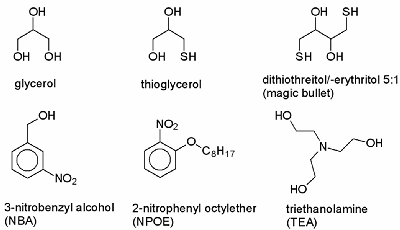a) Enumerate the tasks of a liquid matrix as employed in FAB and LSIMS.
- It has to absorb the primary energy.
- By solvation it helps to overcome intermolecular forces between analyte molecules or ions.
- It provides a continuously refreshing and long-lasting supply of analyte.
- It assists analyte ion formation, e.g., by yielding proton donating/accepting or electron donating/accepting species upon bombardment.
b) Do you know at least three liquid matrices that are commonly in use?

c) What properties should a good matrix have?
- The analyte must be soluble in the matrix.
- Only low-vapor pressure solvents can be easily used as a matrix in conventional FAB-MS.
- The viscosity of the solvent must be low enough to ensure the diffusion of the solutes to the surface.
- Ions from the matrix itself should be as unobtrusive as possible in the resulting FAB spectrum.
- The matrix itself has to be chemically inert. However, specific ion formation reactions promoting the secondary ion yield are beneficial.